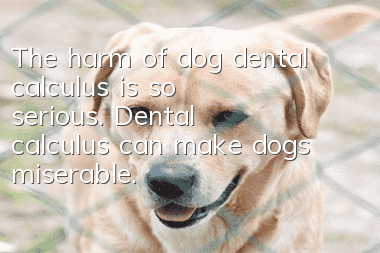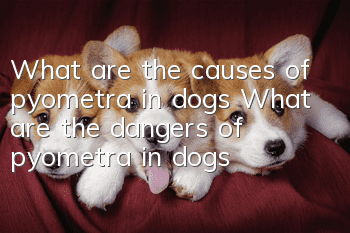The harm of dog dental calculus is so serious. Dental calculus can make dogs miserable.

Causes of dog tooth calculus formation
Plaque is usually the first symptom of pet tooth problems, which refers to soft, transparent or milky white adhesion on the tooth surface, formed by leftover food and bacteria. If the plaque is not removed in time, the minerals in the saliva will turn the plaque into tartar. The early symptoms of dental disease are red and swollen gums. When it worsens further, the gum will become inflamed, bleed, and have bad breath. If the teeth are not cleaned in time, serious cases will lead to tooth loss and tooth sores, and the gums will be permanently damaged, causing the dog to be unable to eat normally. The calculus under the gums is a breeding ground for bacteria, which can cause inflammation. The bacteria that cause gum inflammation can invade your dog's bloodstream and cause lung, kidney, liver and heart problems.The dangers of dental calculus
Dental calculus is a mineral mass attached to the tooth surface. It is formed due to the calcification of dental plaque, which is attached Once dental calculus begins to deposit and form bacterial clumps on the tooth surface, a large amount of dental plaque is more likely to adhere to the surface. The latter calcifies and deposits on the surface of the original dental calculus, gradually increasing the volume of the dental calculus. Therefore, the dental calculus is always covered by plaque. covered. Bacteria and their toxins irritate periodontal tissue and can cause gum inflammation, manifested as red and swollen gums, bad breath, etc. It can further cause periodontitis, which manifests as periodontal tissue inflammation, gum recession, tooth root exposure, loose teeth, and pain or inability to chew.When tartar accumulates and bacteria further corrodes teeth, the gums will begin to fester, and the jawbone will become unstable. Bacteria will also enter the body through blood vessels and affect the functions of the heart, lungs, liver and kidneys. , further endangering the lives of pets. Elderly dogs and cats with accumulated tartar are prone to heart, lung, liver and kidney diseases.
How to prevent dental calculus
Regularly check and remove tartar and calculus in a timely manner. Regularly give dogs and cats chewing gum, rubber and other toys to chew on to exercise teeth and remove dirt. If possible, it is best to use teeth whitening for dogs on a regular basis. Pen smear. Eat dog food to prevent dental calculus early.First, let the dog eat special dog food, and try not to let the dog eat food that is too soft. It is not conducive to the dog's own growth to eat too soft food. On the contrary, it is more beneficial to the dog's own growth. When the dog eats relatively hard food, the dog's teeth can grind in better, which is more beneficial to the dog's health. Teeth are healthy. At the same time, dogs eating hard food can help dogs clean their teeth and clean their mouths.
Secondly, it is best not to feed your dog anything that contains too much sugar. Just like humans will develop moths after eating foods that are too high in sugar, dogs will also eat this kind of food. It will affect the oral health. If necessary, you can rinse the dog's mouth after eating sweets, or the dog must chew it when eating, otherwise the food residue will also cause the appearance of dental calculus in the dog. . Third, the owner can take preventive measures for the dog in advance or brush the dog’s teeth regularly. There are many hospitals that can clean the dog’s teeth. After discovering the disease, the owner can take the dog for treatment or go to the hospital for treatment.Clean your dog’s teeth or brush your dog’s teeth at home.
Random articles
- What medicine should dogs take for urinary tract infection? Key things you need to know about dog urinary tract infection!
- Why do dogs love chewing bones? It turns out that dogs chew bones not just for eating
- What are the shortcomings of Bago? People with light sleep should not keep it.
- What are the advantages of Cane Corso dogs? Only those who have raised them know
- Does a Golden Retriever have bloody stools? There are many reasons for Golden Retrievers to have bloody stools!
- Golden Retriever bathing precautions: owners must pay attention to these aspects
- What should I do if my Husky has ear mites? What are the serious consequences if my Husky has ear mites?
- How long does it take for a Chihuahua to be pregnant? Understand the pregnancy cycle of dogs
- What to do if Teddy has dental calculus. These methods will teach you how to remove dental calculus in your dog.
- Can dog parasites be transmitted to humans? Will the owner’s health be at risk?



